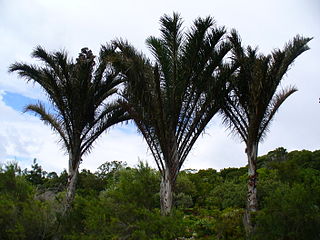
The common blossom bat also known as the southern blossom bat or Queensland blossom bat, is a megabat in the family Pteropodidae. The common blossom bat feeds mostly on nectar and pollen rather than fruit. It is one of eight Pteropodidae species on mainland Australia. It is one of the smallest of all nectarivorous megabats.

The yellow-bellied glider, also known as the fluffy glider, is an arboreal and nocturnal gliding possum that lives in native eucalypt forests in eastern Australia, from northern Queensland south to Victoria.

The little bent-wing bat or little long-fingered bat is a species of vesper bat in the family Miniopteridae. It is found in Australia, Indonesia, the Philippines, and Vanuatu.

The Australian myotis is a species of vesper bat. It is found only in Australia. This taxa may not represent a valid species. Only one specimen has ever been documented, supposedly from New South Wales. This specimen may have been mislabelled or a vagrant Myotis muricola or Myotis ater.

The coastal sheath-tailed bat or coastal tomb bat is a species of sheath-tailed bat in the family Emballonuridae. It is found in Australia and Papua New Guinea.
Juania australis, the Chonta palm, is a species of flowering plant in the Arecaceae family, the only species in the genus Juania. It is a solitary trunked palm tree which is endemic to the Juan Fernández Islands archipelago in the southeast Pacific Ocean west of Chile.

Raphia australis, the giant palm or rafia, is a species of raffia palm in the Arecaceae family. It is found around Kosi Bay in Mozambique and South Africa. It is threatened by habitat loss by agriculture; it is being threatened in Bobole Special Reserve but is secure in Kosi Bay.
Telmatobufo australis is a species of frog in the family Calyptocephalellidae. It is endemic to Chile and occurs in the western and eastern slopes of the Chilean Coast Range in Valdivia and Osorno Provinces. Its natural habitats are fast-flowing streams in temperate Nothofagus forest. It is a rare species threatened by habitat loss that is caused by siltation of streams caused by clear cutting and afforestation with exotic species.
The southern rock lizard is a species of lizard in the family Lacertidae. It is endemic to the Western Cape, South Africa. It occurs in fynbos on the rocky mountain slopes.
Ictalurus australis, the Panuco catfish, is a species of North American freshwater catfish, endemic to the Panuco River basin in Mexico.
Calamoecia is a genus of copepods in the family Centropagidae confined to Australasia. It is thought to have evolved since the separation of the Australian continent from Antarctica. Three of the Australian endemic species are listed as vulnerable species on the IUCN Red List. The genus contains the following species:
Engaeus australis, the lilly pilly burrowing crayfish, is a species of crayfish in the family Parastacidae. It is endemic to Australia.
Calycorectes is a genus of plant in family Myrtaceae first described as a genus in 1856. It is native to South America, southern Mexico, and the Dominican Republic.
Calycorectes schottianus is a species of plant in the Myrtaceae family. It is endemic to Atlantic Forest habitats in Rio de Janeiro (state) of southeastern Brazil.
Calycorectes sellowianus is a species of plant in the Myrtaceae family. It is endemic to Brazil and Argentina.
Calycorectes wurdackii is a species of plant in the Myrtaceae family. It is endemic to Peru.

Gehyra australis, the house gecko, northern dtella or top-end dtella, is a species of gecko native to northern and eastern Australia.
Antennablennius australis, the moustached blenny, is a species of combtooth blenny found in the western Indian Ocean.
The New Guinea free-tailed bat, sometimes designated the New Guinea mastiff bat, is an extant species of free-tailed bat that inhabits the Chimbu highlands of Papua New Guinea. Although Koopman describes A. kuboriensis as a subspecies of the nearby A. australis, the reference catalogue Mammal Species of the World suggests that recent analysis establishes these as distinct species.
Ophiogomphus australis is a dragonfly in the genus Ophiogomphus ("snaketails"), in the family Gomphidae ("clubtails"). Common names are "southern snaketail" and "perennial sow thistle". Ophiogomphus australis is found in North America.










